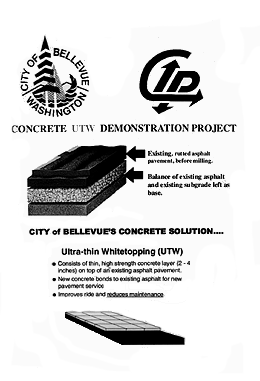|
Subscribe / Renew |
|
|
Contact Us |
|
| ► Subscribe to our Free Weekly Newsletter | |
| home | Welcome, sign in or click here to subscribe. | login |
1999 Building with Concrete and WACA Awards
|
|
Ultra-thin whitetopping: A quick pavement fix
By LUCY BODILLY Got a street that is cracking up? Ultra-thin whitetopping is the Prozac of road repair. Used to fix failing pavements, Ultra-thin whitetopping is the thin layer of concrete that contractors place over traditionally milled asphalt. Stronger and more durable than asphalt, the process promises to last longer than asphalt, and be ready for reuse in a hurry.
Work took place about one year ago. The city experienced constant problems with the intersection because of the heavy traffic coming down a 13 percent slope and stopping at the traffic signal below. Overlays to repair the spot lasted only about five years. The replacement UTW should easily last four times that long, according to Bob Goenen, project manager with the city of Bellevue. The 350-foot-long, 56-foot-wide test section is the first use of the process in the state, but is common in the Midwest. Essentially, UTW is a composite pavement using the existing asphalt road section as a working base. Contractors then lay 2 to 4 inches of concrete directly on the asphalt surface. The city of Bellevue opted to use a 3-inch-deep concrete section, placed on top of a milled asphalt surface. The schedule was similar to a traditional asphalt repair job. To achieve the usual 3,500 psi rating, concrete suppliers devised a special mix that would reach that level in 24 hours. The designers chose combined aggregate gradations for durability, fly ash for workability, type I cement, admixtures and about 2
Goenen is pleased with the project as it nears it first anniversary, despite some cracking at the curb side. "We know that was caused because we used fresh asphalt to fill in where the contractors took out bad sections of asphalt," said Bruce Chattin, executive director of WACA. "The fresh asphalt was not compacted enough." "We will watch it for two years, and them completely evaluate the project," Groenen said. "Before then, the curb area may need some sealing." The speedy turnaround time in the Bellevue project was another consideration in choosing this method. Work was completed over the weekend, and the section could handle heavy traffic again Monday morning. "We would like to give special mention to the city of Bellevue for taking on this demonstration project," Chattin said.
 djc home | top | special issues index
|


